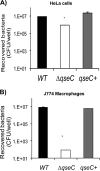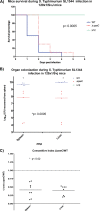QseC mediates Salmonella enterica serovar typhimurium virulence in vitro and in vivo
- PMID: 20028809
- PMCID: PMC2825943
- DOI: 10.1128/IAI.01038-09
QseC mediates Salmonella enterica serovar typhimurium virulence in vitro and in vivo
Erratum in
- Infect Immun. 2010 Aug;78(8):3647
Abstract
The autoinducer-3 (AI-3)/epinephrine (Epi)/norepinephrine (NE) interkingdom signaling system mediates chemical communication between bacteria and their mammalian hosts. The three signals are sensed by the QseC histidine kinase (HK) sensor. Salmonella enterica serovar Typhimurium is a pathogen that uses HKs to sense its environment and regulate virulence. Salmonella serovar Typhimurium invades epithelial cells and survives within macrophages. Invasion of epithelial cells is mediated by the type III secretion system (T3SS) encoded in Salmonella pathogenicity island 1 (SPI-1), while macrophage survival and systemic disease are mediated by the T3SS encoded in SPI-2. Here we show that QseC plays an important role in Salmonella serovar Typhimurium pathogenicity. A qseC mutant was impaired in flagellar motility, in invasion of epithelial cells, and in survival within macrophages and was attenuated for systemic infection in 129x1/SvJ mice. QseC acts globally, regulating expression of genes within SPI-1 and SPI-2 in vitro and in vivo (during infection of mice). Additionally, dopamine beta-hydroxylase knockout (Dbh(-)(/)(-)) mice that do not produce Epi or NE showed different susceptibility to Salmonella serovar Typhimurium infection than wild-type mice. These data suggest that the AI-3/Epi/NE signaling system is a key factor during Salmonella serovar Typhimurium pathogenesis in vitro and in vivo. Elucidation of the role of this interkingdom signaling system in Salmonella serovar Typhimurium should contribute to a better understanding of the complex interplay between the pathogen and the host during infection.
Figures








Similar articles
-
Interplay between the QseC and QseE bacterial adrenergic sensor kinases in Salmonella enterica serovar Typhimurium pathogenesis.Infect Immun. 2012 Dec;80(12):4344-53. doi: 10.1128/IAI.00803-12. Epub 2012 Oct 1. Infect Immun. 2012. PMID: 23027532 Free PMC article.
-
Spatial segregation of virulence gene expression during acute enteric infection with Salmonella enterica serovar Typhimurium.mBio. 2014 Feb 4;5(1):e00946-13. doi: 10.1128/mBio.00946-13. mBio. 2014. PMID: 24496791 Free PMC article.
-
Fur negatively regulates hns and is required for the expression of HilA and virulence in Salmonella enterica serovar Typhimurium.J Bacteriol. 2011 Jan;193(2):497-505. doi: 10.1128/JB.00942-10. Epub 2010 Nov 12. J Bacteriol. 2011. PMID: 21075923 Free PMC article.
-
Salmonella enterica serovar Typhimurium skills to succeed in the host: virulence and regulation.Clin Microbiol Rev. 2013 Apr;26(2):308-41. doi: 10.1128/CMR.00066-12. Clin Microbiol Rev. 2013. PMID: 23554419 Free PMC article. Review.
-
Salmonella effector proteins and host-cell responses.Cell Mol Life Sci. 2011 Nov;68(22):3687-97. doi: 10.1007/s00018-011-0841-0. Epub 2011 Oct 9. Cell Mol Life Sci. 2011. PMID: 21984608 Free PMC article. Review.
Cited by
-
Polyphenols and CRISPR as Quorum Quenching Agents in Antibiotic-Resistant Foodborne Human Pathogens (Salmonella Typhimurium, Campylobacter jejuni and Escherichia coli 0157:H7).Foods. 2024 Feb 15;13(4):584. doi: 10.3390/foods13040584. Foods. 2024. PMID: 38397561 Free PMC article. Review.
-
Biofilms 2009: new perspectives at the heart of surface-associated microbial communities.J Bacteriol. 2010 Jun;192(12):2941-9. doi: 10.1128/JB.00332-10. Epub 2010 Apr 9. J Bacteriol. 2010. PMID: 20382760 Free PMC article. No abstract available.
-
Global transcriptomic response of the AI-3 isomers 3,5-DPO and 3,6-DPO in Salmonella Typhimurium.Arch Microbiol. 2023 Mar 16;205(4):117. doi: 10.1007/s00203-023-03450-x. Arch Microbiol. 2023. PMID: 36929450
-
Association of quorum sensing and biofilm formation with Salmonella virulence: story beyond gathering and cross-talk.Arch Microbiol. 2021 Dec;203(10):5887-5897. doi: 10.1007/s00203-021-02594-y. Epub 2021 Sep 29. Arch Microbiol. 2021. PMID: 34586468 Review.
-
Frenemies: Signaling and Nutritional Integration in Pathogen-Microbiota-Host Interactions.Cell Host Microbe. 2015 Sep 9;18(3):275-84. doi: 10.1016/j.chom.2015.08.007. Cell Host Microbe. 2015. PMID: 26355214 Free PMC article. Review.
References
-
- Ader, R., N. Cohen, and D. Felten. 1995. Psychoneuroimmunology: interactions between the nervous system and the immune system. Lancet 345:99-103. - PubMed
-
- Arnett, C. D., J. Wright, and N. Zenker. 1978. Synthesis and adrenergic activity of benzimidazole bioisosteres of norepinephrine and isoproterenol. J. Med. Chem. 21:72-78. - PubMed
-
- Ashby, M. K. 2004. Survey of the number of two-component response regulator genes in the complete and annotated genome sequences of prokaryotes. FEMS Microbiol. Lett. 231:277-281. - PubMed
Publication types
MeSH terms
Substances
Grants and funding
LinkOut - more resources
Full Text Sources
Miscellaneous

